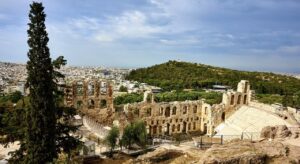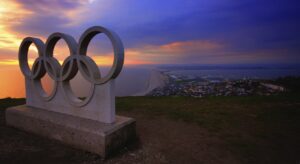The numerous types of physical exercise are evidenced by the monuments of material culture and ancient manuscripts of India, China, Egypt, Persia, Babylon, Assyria.
Mesopotamia. At the end of the IV millennium BC in the interfluve of the Tiber and Euphrates emerged a large number of small Sumerian city-states, each of which was quite an independent socio-historical formation. The largest of them: Ur, Kish, Lagash, Umma and Uruk. At the end of the 3rd millennium BC all the bifurcated area was united into one country, the Akkadian State. This region is considered the cradle of human civilization, as the peoples who inhabited it first began to grow cereals, raise livestock, and work metals. It was here that not only writing and art, but also physical culture were first put at the service of state organization.
The content and character of physical culture was determined by the incessant wars. The art of archery, belt wrestling, fist fights, chariot driving and hunting were highly valued.
The culture of the Sumerians continued to develop further in the states of Babylon and Assyria. All of them fought long wars, so physical education had a military-applied character. Much attention was paid to archery, wrestling, swimming, ritual dances and elements of acrobatics. An important role in the training of warriors in Mesopotamia, the Middle East and the whole of the ancient world was played by the invention of the chariot on horse traction in the early 2nd millennium B.C. The use of horses in military practice changed the content of physical education among the peoples of the Middle East. From an early age, children were taught the basics of horse riding, archery, wrestling, swimming and hunting and prepared for military service.
It is also known that in the life of the Mesopotamian states there were various competitions accompanying the process of training of a warrior. The most famous of them is the ritual games held in honor of the god Marduk, which predate the ancient Olympic Games of the Greeks by more than a thousand years.
In Mesopotamia emerged special schools – “training homes” where boys were trained for the warrior’s profession, going through the hardening, getting accustomed to moderation in eating, self-control, training in throwing spears, wielding edged weapons. Tactical training was perfected in the process of playing “Chess Tents”. The most ancient monument in Assyria, the bronze statues of belted fighters at the moment of fight, created about 2800 B.C., was found.
The training of the future warrior took place in the states of the Middle East until the age of 15-16. Upon joining the army, young men continued to improve their military skills.
Numerous images of hunting, archery, fistfighting and chariot races have testified to the development of physical culture in the Ancient East. The observations of ancient Greek historians Herodotus and Xenophon are interesting, The Persians taught their children at the age of 7-16 years by traditional means of physical training: running, wrestling, archery, riding, javelin-throwing. Moral criteria were of great importance in the upbringing process: education of truthfulness, courage. In educational institutions created at the palaces of rulers there were “educational houses” where various hunting tests, equestrian polo contests, which emerged from a popular Mesopotamian “ball game with a bat”, were cultivated.
Egypt. In the Nile valley at the end of the IV millennium BC emerged Early, and then the Ancient, or Old, Kingdom of Egypt. In the XXIII century B.C. it fell apart, and the transition period lasted until the XVI century B.C., when the Middle Kingdom was formed, which lasted until a new collapse – in the XI century B.C.
In all these historical periods in the Nile valley there was an original system of physical education.
The first evidence of it – images of running competitions – was found in the tomb of the ancient Egyptian king-god (kings in Egypt were considered the embodiment of God on earth) Djoser (2778-2723 B.C.).
Archaeologists found similar drawings in the tomb of Fiochhoten in Sak-kara (mid-3rd millennium BC), where the king-god was depicted in scenes of wrestling, acrobatics, hunting. The artist tried to show agility, courage and strength of the king, who had unlimited power. The existing system of physical education was at the service of the upper class.
During the Middle Kingdom, physical education of Egyptian society greatly expanded as the pharaohs tried to create a new social layer of merchants, soldiers, artisans and petty officials on whom they could rely in their power. Physical education became not only the privilege of the clan nobility, but also entered the everyday life of people of lower social origin. Schools appeared where physical exercises and games were used in the training of officials, priests, temple dancers, and participants in ceremonies dedicated to the Egyptian gods.



